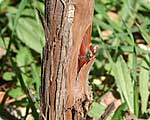Top GraftingChip-Bud graftingAlso known as Chip-budding, this grafting technique requires some practice beforehand, but when performed correctly it can offer extraordinary results in terms of grafting success and growth.Chip-bud grafting can be carried out over a much longer period of time, up to nearly 10 weeks after budburst. Chip-budding can be used to complete T-bud grafts and even to graft trunks of small diameter, renewal spurs and rejuvenation shoots. Chip-bud grafting can also be carried out in autumn with dormant scions in favourable climates (hot temperatures and intense watering are required), and is particularly useful for grafting rootstock directly in the field. The Chip-bud technique consists of inserting a single bud into a notch (on the stock) of exactly the same size and shape. The first cut, at the base of the notch, is made at a 25° angle to the vertical. The blade of the grafting knife should penetrate about 1 cm. The second cut should start 2 to 3 cm above the first, at an angle reduced by half, in order to connect with the first cut. It then involves removing several thin slices of wood (chips) successively. The scion is then wedged in the bottom of the notch by light pressure so that both cambium layers are in contact and ensure an optimum fit. Both sides of the scion and the trunk should line up. Lastly, the graft is wrapped with binding tape. |
|
- adapting grape variety soil terroir
- assortment of grape varieties
- birebent graft
- bud grafting
- chip-bud grafting
- chip-budding
- dormant eye grafting
- field grafting grapevines
- grafting american rootstocks
- grafting onto rooted rootstocks















